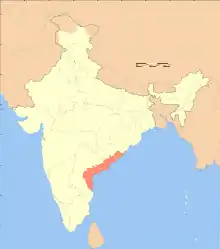Coastline of Andhra Pradesh
The coastline of Andhra Pradesh is located on the southeastern coast of the Indian Peninsula in the Bay of Bengal and is part of the Northern Circars. With a length of 975 km (606 mi), it has the second longest coastline in India after Gujarat. The coastal corridor boasts several ports, harbors, vast stretches of sandy beaches, wildlife and bird sanctuaries, as well as fresh water lakes and estuaries.[1][2]

Geography
The coast extends from Ichchapuram in Srikakulam district to Tirupati district and lies geographically between the coasts of Orissa and Tamil Nadu. Coastal wetlands cover an area of 1,140.7 km2 (440.4 sq mi).[1]
List of coastal districts
Andhra Pradesh has a total of 12 districts that are situated along its coastline. Among these districts, 4 in the Uttaraandhra region, 7 are located in the Kostaandhra region, and 1 in the Rayalaseema region. The list of these districts is as follows:
- Uttaraandhra
- Kostaandhra
- Rayalaseema
Economy
Tourism
These district's has beaches to promote tourism in the state, such as Bheemili Beach, Rushikonda Beach, Bhavanapadu Beach, Ramakrishna Mission Beach, Yarada Beach, Vodarevu Beach, Suryalanka Beach, and Narsapur. Visakhapatnam district, in particular, is home to many beaches.
Fishing and aquaculture
Farmers in coastal areas predominantly engage in fishery, aquaculture, mollusc, and shrimp production as their primary occupations. The geographical location of the state allows for both marine fishing and inland fish production, which is often more profitable than traditional agriculture due to the cultivation of fresh water and brackish water aquaculture.[3][4]
Mineral deposits
The coastal corridor of Andhra Pradesh is rich in minerals such as beach sand, heavy mineral deposits like ilmenite, leucoxene, and monazite. An estimated 241 million tonnes of mineral reserves are present in the beach sand along the state coast.[5]
Silica sand reserves are found in the coastal areas of Prakasam, Nellore, and Guntur districts, and are used for various purposes such as moulding sand, sodium silicate, ceramic, and glass production. Quartzites are found in Orvakal of Kurnool district.[6]
Sea trade
During the medieval period, the British and the Dutch engaged in trade along the coast of India, with the Andhra Pradesh coast being one of their destinations. Evidence of this can be found in some coastal towns, such as Bheemunipatnam. The coastline is home to major, intermediate, and minor ports as well as fishing harbours for sea trade with other countries. Visakhapatnam Port is the largest port on the east coast, and there are several other ports located between Srikakulam district and Krishnapatnam Port in Nellore district.[7]
Tropical cyclonic effects
The Bay of Bengal is known for the frequent occurrence of severe cyclones, with 71 cyclones recorded in the coastal region during 1892-1997. Nellore district leads with 11 severe and 21 normal cyclones. Several factors, such as the lack of flood protection, irrigation systems, drains, and embankments, contribute to severe damage to property in the coastal zone.[8][9]
See also
References
- "Andhra Pradesh Fact File" (PDF). AP State Portal. Archived from the original (PDF) on 3 June 2016. Retrieved 16 July 2014.
- "Length of coastline" (PDF). Ministry of Home Affairs. Archived from the original (PDF) on 21 September 2016. Retrieved 26 August 2016.
- AP top producer of shrimp: MPEDA - The Hindu
- M.A.Mannan (3 January 2013). "Fishing for a fortune". Krishna, West Godavari and Nellore: The India Today Group. Retrieved 16 July 2014.
- "Beach Sand deposits". Department of Mines & Geology. Archived from the original on 18 July 2014. Retrieved 16 July 2014.
- "Silica Sand deposits". Department of Mines & Geology. Archived from the original on 5 August 2014. Retrieved 26 July 2014.
- "Andhra Pradesh : Opening Up Ports". AP Ports. Archived from the original on 22 July 2014. Retrieved 20 July 2014.
- "History of Cyclones in the AP". Disaster Management Department. Government of Andhra Pradesh. Archived from the original on 22 December 2013. Retrieved 20 July 2014.
- "Severe Cyclones in the Bay of Bengal (1970-1999)". India Meteorological Department. Archived from the original on 25 September 2014. Retrieved 20 July 2014.